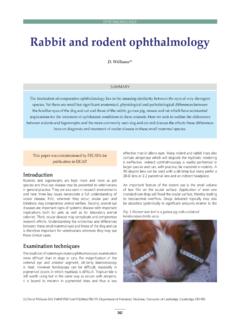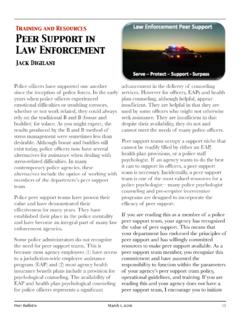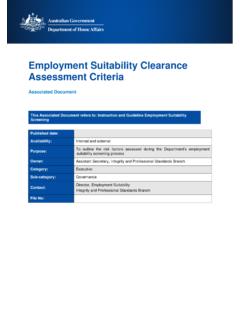Transcription of Wild Bunny rehabilitation - Animal Advocates
1 INTRODUCTIONThey come in from one day old to six weeks old, sometimes full-grown. Most of them are injured, covered with ticks, emaciated, dehydrated, whacked with a weedwacker, mowed by a lawnmower, mauled and/or degloved by a cat, or uncovered and handled by curious humans. They are the lowest mammal in Nature s chain, and so delicate in structure as to be almost impossible to save, rehabilitate and release. They are a pure Animal , insofar as they eat only plant life. Therefore, they represent to the many who caretake them the ultimate in vulnerability and innocence. This manual is dedicated to the thousand and then some cottontails that have been touched, healed, nursed, released and buried by these hands. They have taught me acceptance, release, faith, a deep belief in miracles and so much more.
2 Their total dependence and acceptance of us as caregivers is a true gift. It is because of this gift that I offer to you, other rabbit caregivers, this book of experience and knowledge. Mine is not the only way, and this manual is offered as a source of information only. May you see many lightbulbs go on , may you see more success than you thought you could ever accomplish, and may the flightless wonders in your care return to you time and again to teach and finish the life lessons they bring to us. This manual is dedicated to all rabbit caregivers and to our sleepy-eyed are two special sections, Feeding Tips and Feeding and Handling Techniques that were graciously written for me by:Elaine Peterson LongTexas and Federal PermitsTWRC, IWRC, NWRAR ehabbing 4 years: wild rabbits, songbirds and tree squirrelsEmail: rights reserved.
3 Copyright October 1998 rehabilitation and Release of the Eastern Cottontail1 VITAL STATISTICS Sylvilagus floridanus, otherwise known as the eastern cottontail, is found throughout the southern part of the United States from Virginia to California and also Mexico. It s native habitat is both urban and rural, finding haven in your backyard to a brier patch in a pasture. They will live where their food is in woodlands, pastures, streams and ponds, fields of hay and alfalfa, and in your flowerbed. They nibble all day long and into the evening. Their system requires a continual flow of nutrition and roughage through the gastro-intestinal tract in order to gain the calories needed for maintenance of health. Their favorite foraging times are pre-dawn, early morning, pre-dusk, and twilight.
4 During the course of the day, they will often come out of hiding to nibble on new grass and leaves. By eating at those times of day, there is a dew on the grass and other plants. This is how the cottontail drinks its water. Their ulterior reason for venturing out during the day and risk being sighted by a predator is the luring away of that predator from their nest. The cottontails body temperature resides at 101_ - 103_ Fahrenheit. As their stress increases, so does their temperature. A higher temperature can indicate that their body is fighting off infection. The ears of a rabbit are their thermoregulators, or air conditioners . It is through the fine veins in their ears that heat is released, thus cooling the internal organs and blood. That is why you will see rabbits seemingly panting quite fast so fast that you might think that they should be hyperventilating.
5 They are actually dealing with stress and regulating their body temperature to adequately deal with the given situation. That situation can be transporting to a vet, an attack on its body, disease or illness, or even just picking it up for examination. Rabbits eyes are set on the sides of their heads. They cannot see well and cannot see directly in front of them. They have incredible hearing capacity, taste, and smell, which make up for their poor eyesight. They will sit straight up on their hind legs and sniff the air, listening at the same time to determine the direction of danger or sometimes just to get a good sense of the and Release of the Eastern Cottontail2 A rabbit s metabolism runs almost three times as quickly as a cat or dogs. That is why normal medical dosage amounts must be approached with a discerning eye when diagnosing and prescribing treatment.
6 Anesthetic is quickly absorbed and excreted via the liver. One of the safest anesthetics used today is Isoflurane gas, which does not build up in the liver, and quickly wears off when administration ceases. Another method of gently putting a cottontail under for examination and treatment is immersing it in an anesthetic tank (usually an aquarium). Injectable anesthetics, such as Ace/Rompin/Ketamine, can stop a rabbit s heart by dosing too strongly. Because of their rapid metabolism, a rabbit can also die of shock much easier than almost any other mammal. Cottontails live in social colonies called warrens . The females barely scratch the surface of the ground to make their nest, often in harm s way. It is a fallacy to say that cottontails make horrible mothers.
7 On the contrary, they feed their young twice a day most usually at dawn and dusk. The babies eat while lying on their backs, under their mother, with Mom hovering over them, always at the alert for the first sign of danger. The babies literally open their throats to allow the milk to flow directly into their stomachs. The feeding is usually over in 30 seconds! The mother stimulates and cleans the babies. By silent command the babies stay in their nest while mother stays far away from them keeping them safe from predators except dogs, cats, curious humans and lawnmowers! A cottontail s nest is made of dried grasses, leaves, and fur that is plucked from the abdomen of the mother which allows easy access to her nipples when the kits suckle. Cottontails are born without visible fur, slick and soft to the touch, very embryonic.
8 Their eyes are closed and do not open until they are approximately 10 days old, their ears adhered to the sides of their heads, still unformed and not totally developed. Their eyes and ears open between 7 days and 10 days. They are helpless and totally vulnerable to predators. They can and will crawl from the nest, but usually do stay together until their eyes open. The usual number in a litter ranges from 1 to 8. It is unusual to see more than this in a litter, but we have received in a litter of 11! During times of drought, the number in the litter seems to decrease and in times of plenty, an increase is seen. The gestation time for a cottontail is 28 days give or take a day or two. The mother often has already mated as soon as her babies, called kits, are born.
9 She can produce a litter virtually every month throughout the year. Here in north Texas, we see litters now throughout the year where there was a lull in the December/February timeframe. The life expectancy of a cottontail is between one and two years in the wild and the same as a rehabilitation and Release of the Eastern Cottontail3 domestic rabbit in captivity (5-10 years). When the cottontail s eyes open, their metabolism starts to change along with their dietary requirements. They start the weaning process from the time their eyes open until they are approximately 3 weeks old or less. Cottontails leave the nest when they are three weeks of age or before! That is why we release between the ages of three and five weeks unless there is a medical reason indicated to the contrary.
10 Their instincts have kicked in , they are eating their natural foods, and they can camouflage and hide from the enemy. Cottontails become sexually mature at four to six months of age. The females can and commonly do mature at an even earlier age depending upon the weather, food supply, and predator population. Kits are born with a sterile gut. Their mother s milk provides the enzymes and bacteria (flora) that produce a curd in the gut. That curd is congealed milk and is like the starter for yogurt! From that curd the gastrointestinal tract is then fluorinated with the proper essential elements for the kit to have a healthy system. This process is complete by the time their eyes begin to open and the weaning process starts to take place. Kits are born sometimes with a white blaze on their foreheads.







